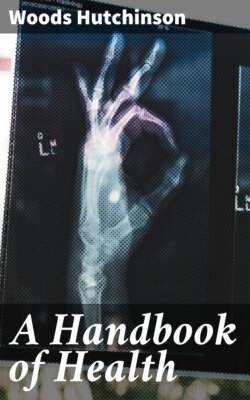Читать книгу A Handbook of Health - Woods Hutchinson - Страница 24
На сайте Литреса книга снята с продажи.
SUGARS
ОглавлениеWhere Sugar is Obtained. The other great member of the starch, or carbohydrate, group of foods is sugar. This is a scarcer and more expensive food than starch because, instead of being found in solid masses in grains and roots like starch, it is scattered, very thinly, through the fruits, stems, and roots of a hundred different plants, seldom being present in greater amounts than two or three per cent. It is, however, so valuable a food, with so high a fuel value, and is so rapidly digested and absorbed, that man has always had a very keen desire for it, or, as we say, a "sweet tooth," and has literally searched the whole vegetable kingdom the world over to discover plants from which it could be secured in larger amounts. During the last two hundred years it has been obtained chiefly from two great sources: the juicy stem of a tall, coarse reed, or cane, the sugar-cane, growing in the tropics; and (within the last fifty years) the sweet juice of the large root of a turnip-like plant, the beet. Another source of sugar, in the earlier days of this country, was the juice or sap of the sugar maple, which is still greatly relished as a luxury, chiefly in the form of syrup.
Honey is nearly pure sugar together with certain ferments and flavoring extracts, derived in part from the flowers from which it is gathered, and in part from the stomach, or crop, of the bee.
The Food Value of Sugar. In the early days of its use, sugar, on account of its expensiveness, was looked upon solely as a luxury, and used sparingly—either as a flavoring for less attractive foods, or as a special treat; and like most new foods, it was declared to be unwholesome and dangerous. But sugar is now recognized as one of our most useful and valuable foods. In fuel value, it is the equal, indeed the superior, weight for weight, of starch; and as all starch has to be changed into it before it can be used by the body, it is evident that sugar is more easily digested and absorbed than starch, and furnishes practically a ready-made fuel for our muscles.
How We should Use Sugar. The drawbacks of sugar are that, on account of its exceedingly attractive taste, we may eat too much of it; and that, because it is so satisfying, if we do eat too much of it either between meals or at the beginning of meals, our appetites will be "killed" before we have really eaten a sufficient supply of nourishing food. But all we have to do to avoid these dangers is to use common sense and a little self-control, without which any one of our appetites may lead us into trouble.
CANDY, LIKE OTHER FOODS, SHOULD BE CLEAN.
Candy sold on the street is always questionable. It should never be bought from a cart or stand that is not covered with glass.
On account of this satisfying property, sugar is best eaten at, or near, the close of a meal; and taken at that time, there is no objection to its use nearly pure, as in the form of sweet-meats, or good wholesome candy. Its alleged injurious effects upon the teeth are largely imaginary and no greater than those of the starchy foods. The teeth of various tropical races which live almost entirely on sugar-cane during certain seasons of the year are among the finest in the world; and any danger may be entirely avoided by proper brushing and cleaning of the teeth and gums after eating.
If eaten in excess, sugar quickly gives rise to fermentation in the stomach and bowels; but so do the starches and the fats, if over-indulged in. Its real value as a food may be judged from the fact that the German army has made it a part of its field ration in the shape of cakes of chocolate, and that the United States Government buys pure candy by the ton, for the use of its soldiers.
